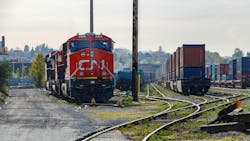A labor dispute between a union and two major Canadian railway companies is disrupting North American freight. The news is likely to move significant freight volumes to trucking's spot market.
Beginning August 22, two major Canadian rail companies have locked out unionized employees and shut down their rail activity. The locked-out employees represent almost 10,000 workers for both companies.
Before it took place, the threat of the work stoppage already moved some freight volume to trucking’s spot market. Now that the stoppage is in effect, the disruption to North American freight will become more severe.
What happened?
The work stoppage came from unsuccessful labor negotiations between two Canadian railway employers and a major industry union: Canadian National Railway Co. and Canadian Pacific Kansas City, the employers, and Teamsters Canada Rail Conference, the union.
CN and CPKC are two of Canada’s biggest rail companies, according to Axios. The effects of a work stoppage for the companies are widespread for railway freight movement.
The two major rail companies had already slowed down the movement of goods before locking out all TCRC-represented employees after midnight on August 22, because no agreement was reached. The union planned to issue a strike against CPKC beginning August 22.
See also: Fleets Explained: How do freight rates work?
How does this affect trucking?
Volumes in the North American spot market are likely to be affected by the stoppage; last week's spot market showed volumes already moving toward trucks.
Nearly a third of the two companies' freight crosses the U.S.-Canadian border, according to CNN.
The translation of halted rail freight to trucking volumes isn't one-to-one. A significant portion of railroad freight cannot effectively move to truck freight, and many shippers have already planned around the disruptions caused by this dispute.
Dean Croke, principal analyst for DAT Freight & Analytics, found that some freight volume already shifted from rails to the road last week, but there is still plenty of capacity for the moment.
To illustrate the effects of the dispute on North American trucking, Croke shared a few key metrics from last week’s dry van spot market in Canada. Increased volumes last week would have come from shippers anticipating the dispute's disruptions. DAT found that:
- The volume of loads from Seattle to Ontario increased 44% last week.
- Load volumes from Toronto to Chicago increased 31%.
- From Toronto to Allentown, rates increased 117%.
- Outbound loads from Toronto increased 29%.
Rates for these routes, meanwhile, were mixed, “indicating plenty of capacity to move loads,” Croke said.
Rates remained flat for Seattle to Ontario, increased by $0.06 for Toronto to Chicago, increased by $0.08 for Toronto to Allentown, and fell $0.02 for Toronto outbound loads.
Croke called these metrics "early signs that volume is moving to the road, but there's still plenty of capacity at the moment."
Companies like DAT will be keeping a close eye on freight volumes as the work stoppage moves forward. If the work stoppage continues beyond shippers' and rail companies' expectations, a greater volume of freight will move to the Canada-U.S. spot market. If this shift in freight exceeds regional carriers' capacity, rates could rise sharply.
Who is disrupting railway freight?
TCRC, CN, and CPKC have each contributed to stopping the flow of railway goods in Canada. The union issued a strike notice to one of the companies—but both companies decided to issue a lockout.
Each side blames the other for the disruption, saying the opposing side is unwilling to compromise to reach a deal.
A potential for a strike is a union’s only major bargaining tool: the threat that union employees will collectively refuse to work for an employer until both parties reach an adequate deal. A lockout can be an employer’s preemptive response to the threat and is the antithesis of a strike: A company refuses to allow unionized employees to work.
Both strikes and lockouts are considered work stoppages, and both are disruptive to a given industry.
Subject to Canadian regulations, neither the union nor rail companies could initiate a work stoppage until they received federal approval in the interest of public safety. In May, the Canadian federal government tasked its Canada Industrial Relations Board to decide whether the work stoppage would “cause an immediate threat to public health and safety.”
On August 9, CIRB issued its decision that none of the services provided by the railways are essential to Canadian public health and safety—allowing the possibility of a work stoppage after 13 days.
On August 18, TCRC issued a 72-hour strike notice (the advance notice is also mandated by Canadian regulations) to CPKC, planning a walkout after midnight on August 22.
In response to the threat of a strike after the CIRB decision, both CN and CPKC began to slow down the movement of dangerous goods. After TCRC’s strike notice, both companies announced plans to enact a lockout of all TCRC-represented employees beginning August 22. CN’s shipment embargo schedule is available here and CPKC’s embargo schedule is available here.
“Despite negotiations over the weekend, no meaningful progress has occurred, and the parties remain very far apart,” CN stated in its lockout notice on August 18. “Unless there is an immediate and definite resolution to the labor conflict, CN will have no choice but to continue the phased and progressive shutdown of its network, which would culminate in a lockout.”
About the Author
Jeremy Wolfe
Editor
Editor Jeremy Wolfe joined the FleetOwner team in February 2024. He graduated from the University of Wisconsin-Stevens Point with majors in English and Philosophy. He previously served as Editor for Endeavor Business Media's Water Group publications.

